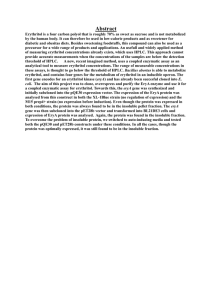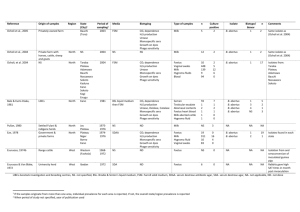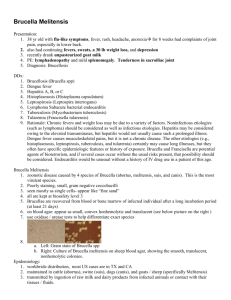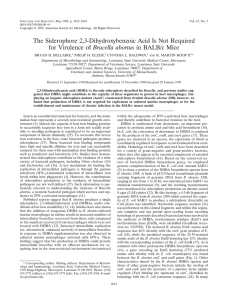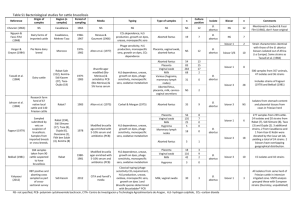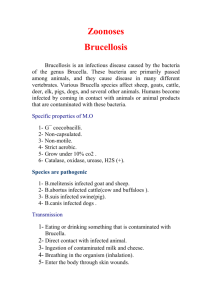I , May 2003, p. 2927–2932 Vol. 71, No. 5 ⫹0 DOI: 10.1128/IAI.71.5.2927–2932.2003
advertisement
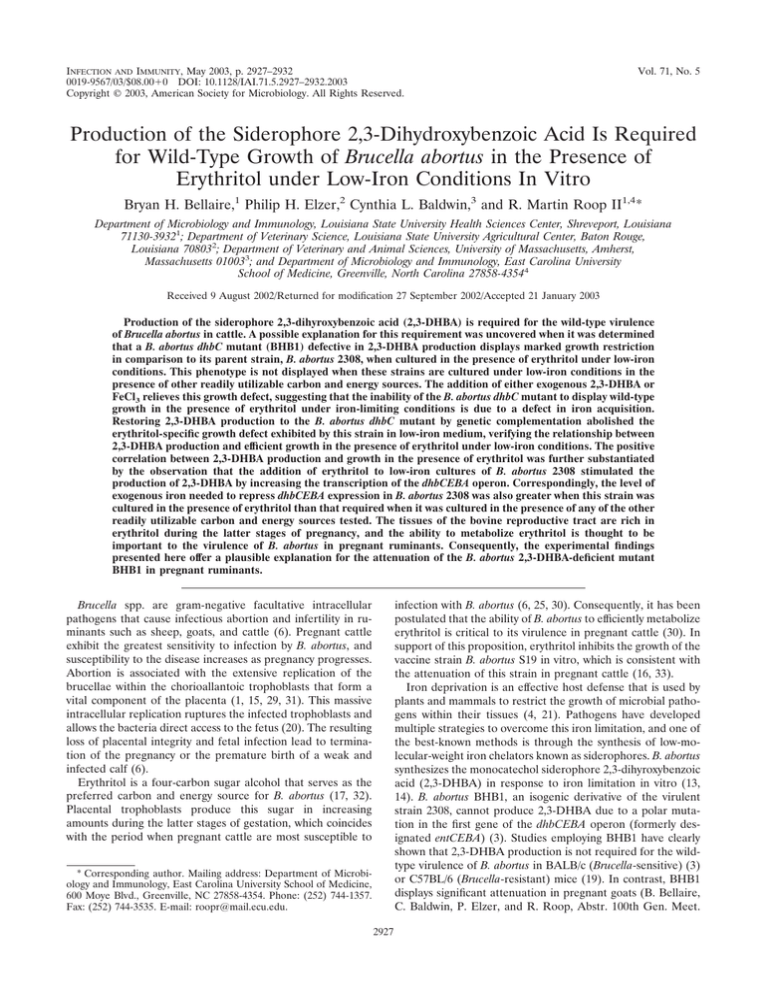
INFECTION AND IMMUNITY, May 2003, p. 2927–2932 0019-9567/03/$08.00⫹0 DOI: 10.1128/IAI.71.5.2927–2932.2003 Copyright © 2003, American Society for Microbiology. All Rights Reserved. Vol. 71, No. 5 Production of the Siderophore 2,3-Dihydroxybenzoic Acid Is Required for Wild-Type Growth of Brucella abortus in the Presence of Erythritol under Low-Iron Conditions In Vitro Bryan H. Bellaire,1 Philip H. Elzer,2 Cynthia L. Baldwin,3 and R. Martin Roop II1,4* Department of Microbiology and Immunology, Louisiana State University Health Sciences Center, Shreveport, Louisiana 71130-39321; Department of Veterinary Science, Louisiana State University Agricultural Center, Baton Rouge, Louisiana 708032; Department of Veterinary and Animal Sciences, University of Massachusetts, Amherst, Massachusetts 010033; and Department of Microbiology and Immunology, East Carolina University School of Medicine, Greenville, North Carolina 27858-43544 Received 9 August 2002/Returned for modification 27 September 2002/Accepted 21 January 2003 Production of the siderophore 2,3-dihyroxybenzoic acid (2,3-DHBA) is required for the wild-type virulence of Brucella abortus in cattle. A possible explanation for this requirement was uncovered when it was determined that a B. abortus dhbC mutant (BHB1) defective in 2,3-DHBA production displays marked growth restriction in comparison to its parent strain, B. abortus 2308, when cultured in the presence of erythritol under low-iron conditions. This phenotype is not displayed when these strains are cultured under low-iron conditions in the presence of other readily utilizable carbon and energy sources. The addition of either exogenous 2,3-DHBA or FeCl3 relieves this growth defect, suggesting that the inability of the B. abortus dhbC mutant to display wild-type growth in the presence of erythritol under iron-limiting conditions is due to a defect in iron acquisition. Restoring 2,3-DHBA production to the B. abortus dhbC mutant by genetic complementation abolished the erythritol-specific growth defect exhibited by this strain in low-iron medium, verifying the relationship between 2,3-DHBA production and efficient growth in the presence of erythritol under low-iron conditions. The positive correlation between 2,3-DHBA production and growth in the presence of erythritol was further substantiated by the observation that the addition of erythritol to low-iron cultures of B. abortus 2308 stimulated the production of 2,3-DHBA by increasing the transcription of the dhbCEBA operon. Correspondingly, the level of exogenous iron needed to repress dhbCEBA expression in B. abortus 2308 was also greater when this strain was cultured in the presence of erythritol than that required when it was cultured in the presence of any of the other readily utilizable carbon and energy sources tested. The tissues of the bovine reproductive tract are rich in erythritol during the latter stages of pregnancy, and the ability to metabolize erythritol is thought to be important to the virulence of B. abortus in pregnant ruminants. Consequently, the experimental findings presented here offer a plausible explanation for the attenuation of the B. abortus 2,3-DHBA-deficient mutant BHB1 in pregnant ruminants. infection with B. abortus (6, 25, 30). Consequently, it has been postulated that the ability of B. abortus to efficiently metabolize erythritol is critical to its virulence in pregnant cattle (30). In support of this proposition, erythritol inhibits the growth of the vaccine strain B. abortus S19 in vitro, which is consistent with the attenuation of this strain in pregnant cattle (16, 33). Iron deprivation is an effective host defense that is used by plants and mammals to restrict the growth of microbial pathogens within their tissues (4, 21). Pathogens have developed multiple strategies to overcome this iron limitation, and one of the best-known methods is through the synthesis of low-molecular-weight iron chelators known as siderophores. B. abortus synthesizes the monocatechol siderophore 2,3-dihyroxybenzoic acid (2,3-DHBA) in response to iron limitation in vitro (13, 14). B. abortus BHB1, an isogenic derivative of the virulent strain 2308, cannot produce 2,3-DHBA due to a polar mutation in the first gene of the dhbCEBA operon (formerly designated entCEBA) (3). Studies employing BHB1 have clearly shown that 2,3-DHBA production is not required for the wildtype virulence of B. abortus in BALB/c (Brucella-sensitive) (3) or C57BL/6 (Brucella-resistant) mice (19). In contrast, BHB1 displays significant attenuation in pregnant goats (B. Bellaire, C. Baldwin, P. Elzer, and R. Roop, Abstr. 100th Gen. Meet. Brucella spp. are gram-negative facultative intracellular pathogens that cause infectious abortion and infertility in ruminants such as sheep, goats, and cattle (6). Pregnant cattle exhibit the greatest sensitivity to infection by B. abortus, and susceptibility to the disease increases as pregnancy progresses. Abortion is associated with the extensive replication of the brucellae within the chorioallantoic trophoblasts that form a vital component of the placenta (1, 15, 29, 31). This massive intracellular replication ruptures the infected trophoblasts and allows the bacteria direct access to the fetus (20). The resulting loss of placental integrity and fetal infection lead to termination of the pregnancy or the premature birth of a weak and infected calf (6). Erythritol is a four-carbon sugar alcohol that serves as the preferred carbon and energy source for B. abortus (17, 32). Placental trophoblasts produce this sugar in increasing amounts during the latter stages of gestation, which coincides with the period when pregnant cattle are most susceptible to * Corresponding author. Mailing address: Department of Microbiology and Immunology, East Carolina University School of Medicine, 600 Moye Blvd., Greenville, NC 27858-4354. Phone: (252) 744-1357. Fax: (252) 744-3535. E-mail: roopr@mail.ecu.edu. 2927 2928 NOTES INFECT. IMMUN. FIG. 1. Growth restriction displayed by the B. abortus dhbC mutant BHB1 during growth in low-iron minimal medium (13) supplemented with 0.5% meso-erythritol. Am. Soc. Microbiol., abstr. B-17, 2000) and cattle (B. H. Bellaire, P. H. Elzer, S. Hagius, J. Walker, C. L. Baldwin, and R. M. Roop II, submitted for publication) compared to the virulent parental strain B. abortus 2308. Although the presence of substantial concentrations of erythritol in the ruminant reproductive tract during the latter stages of gestation has been postulated to be a critical determinant for the virulence of B. abortus in these animals (29, 30), the same relationship does not appear to hold for the virulence of B. abortus in the mouse model. Erythritol is not considered to be a component of murine tissues, and B. abortus strains carrying defined mutations in the genes responsible for erythritol catabolism (eryABCD) retain wild-type virulence in experimentally infected mice (26). Consequently, it was quite interesting when further evaluation of the phenotypic properties of the B. abortus dhbC mutant BHB1 revealed that this strain displays significant growth restriction compared to the parental 2308 strain when cultured in the presence of erythritol in the oxine-extracted low-iron minimal medium described by LópezGoñi et al. (Fig. 1). Inocula for low-iron cultures were prepared by growing B. abortus strains for 48 h in brucella broth, harvesting the cells, washing them with either phosphate-buffered saline or low-iron medium, and resuspending cells in low-iron medium to an optical density at 600 nm (OD600) of 0.15 to 0.25. These cell suspensions were then added to 15 ml of sterile low-iron medium in a 50-ml conical centrifuge tube at an inoculum of 0.1% and were incubated with shaking at 37°C. Restricted growth for the dhbC mutant BHB1 compared to that of strain 2308 was observed at concentrations of mesoerythritol ranging from 0.1 to 1.0% in the low-iron minimal medium. Restricted growth of BHB1 in comparison with 2308 was not observed when these strains were cultured in the low-iron minimal medium supplemented with glucose, galac- tose, arabinose, sucrose, or glycerol (data not shown) or when these strains were grown in the presence of erythritol in the low-iron minimal medium supplemented with 50 mM FeCl3 (Fig. 2). Moreover, BHB1 displayed a growth profile comparable to that of the parental 2308 strain in brucella broth and in brucella broth supplemented with 0.1 to 1.0% meso-erythritol (data not shown). These experimental findings suggest that the production of 2,3-DHBA is required for the wild-type growth of B. abortus 2308 in the presence of erythritol under low-iron conditions. Genetic complementation was used to verify the link between the 2,3-DHBA-negative phenotype of B. abortus BHB1 and the inability of this strain to grow efficiently in the presence of erythritol in the low-iron minimal medium. To facilitate the complementation of the dhbC mutation in trans, the polar dhbC::knr disruption present in BHB1 was replaced with an in-frame, nonpolar ⌬dhbC mutation. The nonpolar dhbC mutation harbors the same 261-bp EcoRV internal deletion used for construction of the polar dhbC::knr allele; however, the remaining portions of the dhbC open reading frame were ligated together without introducing an antibiotic resistance cassette, resulting in the construction of plasmid pBH28. A 2.1-kb fragment containing the dhbC gene harboring the internal inframe deletion was removed from pBH28 by digestion with EcoRI. This fragment was incubated with the Klenow fragment of DNA polymerase I (Promega) to fill in its protruding 5⬘ ends and cloned into the SmaI site of the sacB-containing vector pEX100T (28). The resulting plasmid construct was used in a sucrose-resistance based counterselection strategy (24) to introduce the nonpolar dhbC mutation into B. abortus 2308. The nonpolar dhbC mutant constructed in this manner was designated BHB2. The genotype of this mutant was confirmed by PCR, and the 2,3-DHBA-negative phenotype of this strain was VOL. 71, 2003 FIG. 2. Exogenous FeCl3 (50 M) enhances the growth of B. abortus BHB1 (⌬dhbC) in low-iron minimal medium supplemented with 0.5% meso-erythritol. Culture density is presented on a log scale, and results shown are representative of those obtained from multiple experiments. verified by the Arnow assay. As expected, and in a fashion similar to that for BHB1, BHB2 displayed growth restriction in the presence of erythritol in the low-iron minimal medium (Fig. 3). Electrotransformation of BHB2 with a pBBR1MCS-4 derivative (12) carrying a 2.3-kb EcoRI fragment containing the B. abortus dhbC gene restored 2,3-DHBA production by this strain. More importantly, introduction of the cloned dhbC allowed BHB2 to display wild-type growth in the presence of erythritol in the low-iron minimal medium (Fig. 3), thereby confirming the link between the dhbC mutation in this strain and its inability to grow efficiently in the presence of erythtritol in the low-iron minimal medium from a genetic standpoint. The precise basis for the inability of the B. abortus dhbC mutants to grow efficiently in the presence of erythritol in the low-iron minimal medium is unknown. One possibility, however, is that the catabolism of erythritol during growth in this medium imposes an increased physiologic requirement for iron on this bacterium compared to the utilization of the other carbon and energy sources available in this medium. One of the enzymes involved in the conversion of erythritol to dihydroxyacetone phosphate, 3-keto-L-erythrose 4-phosphate dehydrogenase, is an iron-containing, membrane-bound flavoprotein that appears to be directly linked to the electron transport system in B. abortus (32). Aconitase, a key enzyme in the tricarboxylic acid cycle, is another iron-containing enzyme whose activity is sensitive to intracellular iron levels (11). Based on our present knowledge of carbohydrate metabolism in Brucella (8, 22, 23), the combination of these two potentially iron-sensitive steps is predicted to be unique for the catabolism of erythritol among the carbon and energy sources examined in this study. An increased need for iron during the catabolism of erythritol would also explain the observation that the addition of exogenous FeCl3 (Fig. 2) or 2,3-DHBA (data not shown) relieves the growth restriction displayed by BHB1 during growth in the presence of erythritol in the low-iron minimal medium. Further examination of the relationship between 2,3-DHBA NOTES 2929 FIG. 3. Genetic complementation of the erythritol-induced growth restriction of the B. abortus nonpolar dhbC mutant BHB2 by a plasmid-borne cloned copy of dhbC. Growth was evaluated by determining the OD600 of cultures following 36 h of growth in low-iron medium (13) supplemented with 0.1% meso-erythritol. Triplicate samples from each culture were used to calculate standard deviations, and results presented are from a representative experiment. production by the parental strain B. abortus 2308 and growth of this strain in the presence of erythritol in the low-iron minimal medium provided additional evidence supporting the proposition that this bacterium experiences an increased need for iron under these growth conditions that appears to be erythritol specific. For instance, when 2,3-DHBA production by B. abortus 2308 grown in low-iron minimal medium was compared to that observed in 2308 cultures grown in low-iron minimal medium supplemented with erythritol to final concentrations ranging from 0.1 to 1% (wt/vol), it was noted that erythritol supplementation had a profound stimulatory effect on 2,3DHBA production by B. abortus 2308 during growth under iron-restricted conditions (Fig. 4). This enhancement in siderophore production was not observed for iron-restricted cultures of strain 2308 grown in the presence of other readily utilizable carbon and energy sources including glucose, galactose, succinate, arabinose, xylose, and maltose (data not shown). To confirm that the higher levels of 2,3-DHBA produced by iron-restricted cultures of B. abortus 2308 during growth in the presence of erythritol were the result of increased transcription of the dhbCEBA genes, B. abortus 2308 harboring a plasmid-borne dhbC::lacZ reporter was grown in iron-replete and iron-depleted minimal medium, with or without added erythritol. Plasmid pPdhbC::lacZ was constructed by cloning a 221-bp region containing the B. abortus dhbC promoter upstream of the promoterless lacZ gene in pMR15 (9). This plasmid was introduced into B. abortus 2308 by electroporation (5), and -galactosidase production by the plasmidbearing 2308 culture was determined by using the methods described by Miller (18). pMR15 is a derivative of the lowcopy-number, broad-host-range plasmid RK2, and plasmids of this lineage are typically maintained in B. abortus 2308 at two to four copies per genome equivalent (24). Significant -galactosidase activity was detected only in the iron-deprived cultures 2930 NOTES INFECT. IMMUN. FIG. 4. Erythritol-associated stimulation of 2,3-DHBA production by B. abortus 2308 during growth in low-iron minimal medium (13). Samples from an unsupplemented low-iron minimal medium culture (2308) and a low-iron minimal medium culture supplemented with 1.0% erythritol prior to inoculation (2308 Ery) were harvested at the indicated times and analyzed for growth and siderophore production. (A) Growth was recorded as OD600 and was plotted on a logarithmic scale. (B) 2,3-DHBA levels were determined by the Arnow assay (2). To account for differences in growth rates between separate cultures, Arnow results are presented as a ratio of Arnow activity over culture density for each sample collected (A510/OD600). In statistical comparison, normalized Arnow values from erythritol-supplemented cultures were significantly greater than those from non-erythritol-supplemented cultures (P ⱕ 0.01; paired t test analysis). p.i., postinoculation. of B. abortus 2308 bearing pPdhbC::lacZ (Fig. 5), and considerably higher levels of dhbC::lacZ expression were observed in the iron-restricted cultures containing erythritol than in the nonsupplemented cultures. If the increase in dhbC transcription associated with erythritol supplementation of the low-iron minimal medium is a consequence of an increased physiologic demand for iron by B. abortus during growth in the presence of this compound, then higher levels of iron should be necessary to repress dhbC transcription during growth in the presence of erythritol in lowiron minimal medium than are required to repress transcription of this gene during growth in low-iron medium lacking this compound. This is exactly the relationship that was observed when increasing levels of FeCl3 were added to iron-restricted B. abortus 2308 cultures grown with and without erythritol supplementation (Fig. 6). These findings are consistent with erythritol catabolism imposing an increased physiologic demand for iron on B. abortus compared to that imposed by other carbon and energy sources. The evidence presented above strongly suggests that B. abortus 2308 experiences an increased need for iron during the catabolism of erythritol that is not experienced during the catabolism of the carbon and energy sources normally contained in the low-iron minimal medium or of the carbon and energy sources other than erythritol added to this medium during the course of this study. These experimental findings also argue that it is this enhanced physiologic need for iron that drives the increased dhbCEBA transcription that is observed in B. abortus 2308 when this strain is grown in the presence of erythritol under iron-restricted conditions. A possibility that was not addressed in this work, however, is the potential for dual regulation of the 2,3-DHBA biosynthesis operon by both (i) an iron-responsive transcriptional regulator such as the ferric uptake regulator (Fur) (7) and (ii) the erythritol-responsive transcriptional repressor EryD (27). The eryD gene resides in an operon with eryA, -B, and -C, the genes encoding the enzymes catalyzing the initial steps of the erythritol catabolism pathway. Experimental evidence suggests that EryD represses VOL. 71, 2003 FIG. 5. Iron-dependent stimulation of B. abortus 2308 dhbC transcription by erythritol. Transcription of dhbC was measured by monitoring the activity of the dhbC::lacZ reporter in plasmid pPdhbC::lacZ following 20 h of growth of 2308 in low-iron medium without (⫺Fe) and with (⫹Fe) 100 M FeCl3 and with or without 0.1% erythritol. The -galactosidase activity of each culture was determined by using the methods described by Miller (18). The results presented are from a representative experiment, and statistical significance was calculated (P ⬍ 0.001) by t test analysis by using replicate samples for each culture condition. transcription of the eryABCD operon in the absence of erythritol. When erythritol is present, the repressor function of EryD in nullified and active transcription of the eryABCD operon ensues. If EryD exerts a similar form of regulation FIG. 6. Erythritol- and iron-dependent repression of dhbC expression. To determine the amount of exogenous iron needed to repress dhbC transcription, B. abortus 2308 (pPdhbC::lacZ) was grown in lowiron medium supplemented with increasing amounts of FeCl3 in either the presence or absence of erythritol. Cells were harvested after 24 h of incubation under these conditions, and the -galactosidase activity of each culture was determined by using the methods described by Miller (18). In statistical comparison, -galactosidase activity from erythritol-supplemented cultures was significantly greater than that from non-erythritol-supplemented cultures at each iron concentration examined (P ⬍ 0.01; paired t test analysis using replicate samples for each growth condition). Results presented are from a single experimental trial and are representative of the results obtained from multiple experiments. NOTES 2931 upon the dhbCEBA operon, then it is possible that the increase in dhbCEBA transcription observed during the growth of B. abortus 2308 in the presence of erythritol in the low-iron minimal medium is the result of erythritol serving as a direct stimulus for increased transcription of the 2,3-DHBA biosynthesis operon (through inactivation of the repressor properties of EryD) and not simply a consequence of an increased physiologic need for iron by this bacterium during the catabolism of erythritol. Such a direct relationship between the presence of erythritol and dhbCEBA transcription could well explain the increase in 2,3-DHBA production observed in B. abortus 2308 during growth in the presence of erythritol in the low-iron minimal medium. It is hard to envision, however, how such a relationship could explain the growth restriction experienced by the isogenic B. abortus dhbC mutants during culture in the presence of erythritol in the low-iron minimal medium or the capacity of exogenous FeCl3 or 2,3-DHBA to relieve this growth restriction. Nevertheless, it will be important to evaluate the erythritol responsiveness of dhbCEBA transcription during growth in the low-iron minimal medium in B. abortus strains carrying well-defined mutations in the erythritol catabolism genes to better define the link between expression of the dhbCEBA operon and erythritol catabolism in this bacterium. Iron restriction is an important component of the innate immune response in mammals (4, 21), and B. abortus almost certainly faces a considerable iron deficit during its residence in the erythritol-rich environment of the bovine reproductive tract. Given the proposed link between erythritol metabolism and the virulence of this bacterium in pregnant ruminants (30), the inability of the B. abortus dhbC mutant BHB1 to display wild-type growth in the presence of erythritol in low-iron minimal medium offers a plausible explanation for the failure of the mutant to induce abortion in pregnant cattle (Bellaire et al., submitted) and goats (Bellaire et al., Abstr. 100th Gen. Meet. Am. Soc. Microbiol.) and potentially defines a role for 2,3-DHBA production in virulence in the ruminant reproductive tract. Establishing a definitive link between the inefficient replication of the B. abortus dhbC mutants in the presence of erythritol under low-iron conditions and their attenuation, however, will require a direct comparison of the virulence properties of these strains in pregnant and nonpregnant cattle with isogenic B. abortus strains carrying mutations in the erythritol catabolism genes (eryABCD) (27). Considering that the genes surrounding the B. abortus dhbCEBA operon appear to be involved in the conversion of 2,3-DHBA into the recently described, more complex catechol siderophore brucebactin (10) (Bellaire et al., unpublished), it will also be important to examine the contribution of brucebactin to efficient erythritol metabolism by B. abortus under low-iron conditions and the virulence of this bacterium in ruminants. Plasmid pMR15 was a gift from Lucy Shapiro, Department of Developmental Biology, Stanford University School of Medicine. This work was supported by grants (95-01995 and 98-02620) from the U.S. Department of Agriculture’s National Research Initiative Competitive Research Grants Program. REFERENCES 1. Alexander, B., P. R. Schnurrenberger, and R. R. Brown. 1981. Numbers of Brucella abortus in the placenta, umbilicus and fetal fluid of two naturally infected cows. Vet. Rec. 108:500. 2932 NOTES 2. Arnow, L. E. 1937. Colorimetric determination of the components of 3,4dihydroxyphenyalanin-tyrosine mixtures. J. Biol. Chem. 118:531–537. 3. Bellaire, B. H., P. H. Elzer, C. L. Baldwin, and R. M. Roop II. 1999. The siderophore 2,3-dihydroxybenzoic acid is not required for virulence of Brucella abortus in BALB/c mice. Infect. Immun. 67:2615–2618. 4. Byers, B. R., and J. E. Arceneaux. 1998. Microbial iron transport: iron acquisition by pathogenic microorganisms. Met. Ions Biol. Syst. 35:37–66. 5. Elzer, P. H., R. W. Phillips, M. E. Kovach, K. M. Peterson, and R. M. Roop II. 1994. Characterization and genetic complementation of a Brucella abortus high-temperature-requirement A (htrA) deletion mutant. Infect. Immun. 62:4135–4139. 6. Enright, F. M. 1990. The pathogenesis and pathobiology of Brucella infections in domestic animals, p. 301–320. In K. H. Nielsen and J. R. Duncan (ed.), Animal brucellosis. CRC Press, Boca Raton, Fla. 7. Escolar, L., J. Perez-Martin, and V. de Lorenzo. 1999. Opening the iron box: transcriptional metalloregulation by the Fur protein. J. Bacteriol. 181:6223– 6229. 8. Essenberg, R. C., R. Seshadri, K. Nelson, and I. Paulsen. 2002. Sugar metabolism by brucellae. Vet. Microbiol. 90:249–261. 9. Gober, J. W., and L. Shapiro. 1992. A developmentally regulated Caulobacter flagellar promoter is activated by 3⬘ enhancer and IHF binding elements. Mol. Biol. Cell 3:913–926. 10. González Carreró, M. I., F. J. Sangari, J. Agüero, and J. M. García Lobo. 2002. Brucella abortus strain 2308 produces brucebactin, a highly efficient catecholic siderophore. Microbiology 148:353–360. 11. Griffiths, E. 1999. Iron in biological systems, p. 1–26. In J. J. Bullen and E. Griffiths (ed.), Iron and infection. John Wiley & Sons, New York, N.Y. 12. Kovach, M. E., P. H. Elzer, D. H. Hill, G. T. Robertson, M. A. Farris, R. M. Roop II, and K. M. Peterson. 1995. Four new derivatives of the broad-hostrange cloning vector pBBR1MCS carrying different antibiotic-resistance cassettes. Gene 166:175–176. 13. López-Goñi, I., I. Moriyón, and J. B. Neilands. 1992. Identification of 2,3dihydroxybenzoic acid as a Brucella abortus siderophore. Infect. Immun. 60:4496–4503. 14. López-Goñi, I., and I. Moriyón. 1995. Production of 2,3-dihydroxybenzoic acid by Brucella species. Curr. Microbiol. 31:291–293. 15. Meador, V. P., and B. L. Deyoe. 1989. Intracellular localization of Brucella abortus in bovine placenta. Vet. Pathol. 26:513–515. 16. Meyer, M. E. 1966. Metabolic characterization of the genus Brucella. V. Relationship of strain oxidation rate of i-erythritol to strain virulence for guinea pigs. J. Bacteriol. 92:584–588. 17. Meyer, M. E. 1967. Metabolic characterization of the genus Brucella. VI. Growth stimulation by i-erythritol compared with strain virulence for guinea pigs. J. Bacteriol. 93:996–1000. Editor: J. T. Barbieri INFECT. IMMUN. 18. Miller, J. H. 1972. Experiments in molecular genetics. Cold Spring Harbor Laboratory Press, Cold Spring Harbor, N.Y. 19. Parent, M. A., B. H. Bellaire, E. A. Murphy, R. M. Roop II, P. H. Elzer, and C. L. Baldwin. 2002. Brucella abortus siderophore 2,3-dihydroxybenzoic acid (DHBA) facilitates intracellular survival of the bacteria. Microb. Pathog. 32:239–248. 20. Payne, J. M. 1959. The pathogenesis of experimental brucellosis in the pregnant cow. J. Pathol. Bacteriol. 78:447–463. 21. Ratledge, C., and L. G. Dover. 2000. Iron metabolism in pathogenic bacteria. Annu. Rev. Microbiol. 54:881–941. 22. Robertson, D. C., and W. G. McCullough. 1968. The glucose catabolism of the genus Brucella. I. Evaluation of pathways. Arch. Biochem. Biophys. 127:263–273. 23. Robertson, D. C., and W. G. McCullough. 1968. The glucose catabolism of the genus Brucella. II. Cell-free studies with B. abortus (S-19). Arch. Biochem. Biophys. 127:445–456. 24. Robertson, G. T., A. Reisenauer, R. Wright, R. B. Jensen, A. Jensen, L. Shapiro, and R. M. Roop II. 2000. The Brucella abortus CcrM DNA methyltransferase is essential for viability, and its overexpression attenuates intracellular replication in murine macrophages. J. Bacteriol. 182:3482–3489. 25. Samartino, L. E., and F. M. Enright. 1993. Pathogenesis of abortion of bovine brucellosis. Comp. Immunol. Microbiol. Infect. Dis. 16:95–101. 26. Sangari, F. J., M. J. Grilló, M. P. Jiménez de Bagües, M. I. GonzálezCarreró, J. M. García-Lobo, J. M. Blasco, and J. Agüero. 1998. The defect in the metabolism of erythritol of the Brucella abortus B19 vaccine strain is unrelated with its attenuated virulence in mice. Vaccine 16:1640–1645. 27. Sangari, F. J., J. Agüero, and J. M. García-Lobo. 2000. The genes for erythritol catabolism are organized as an inducible operon in Brucella abortus. Microbiology 146:487–495. 28. Schweitzer, H. P., and T. T. Hoang. 1995. An improved system for gene replacement and xylE fusion analysis in Pseudomonas aeruginosa. Gene 158: 15–22. 29. Smith, H., J. Keppie, J. H. Pearce, R. Fuller, and A. E. Williams. 1961. The chemical basis of the virulence of Brucella abortus. I. Isolation of Br. abortus from bovine foetal tissue. Br. J. Exp. Pathol. 42:631–637. 30. Smith, H., A. E. Williams, J. H. Pearce, J. Keppie, P. W. Harris-Smith, R. B. Fitzgeorge, and K. Witt. 1962. Foetal erythritol: a cause of the localization of Brucella abortus in bovine contagious abortion. Nature 193:47–49. 31. Smith, T. 1919. A characteristic localization of Bacillus abortus in the bovine fetal membranes. J. Exp. Med. 29:451–455. 32. Sperry, J. F., and D. C. Robertson. 1975. Erythritol catabolism by Brucella abortus. J. Bacteriol. 121:619–630. 33. Sperry, J. F., and D. C. Robertson. 1975. Inhibition of growth by erythritol catabolism in Brucella abortus. J. Bacteriol. 124:391–397.
